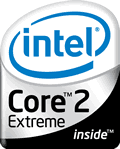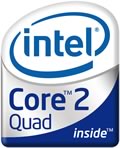Intel QX6700
1. Introduction
Review Pages
2. Conroe QX6700 (Kentsfield)
3. Installation
4. Tests
5. Everest Ultimate Edition 2006
6. PCMARK - 3DMARK
7. Science Mark - Nero Digital
8. CINEBENCH -SuperPI
9. F.E.A.R.
10. Splinter Cell Chaos Theory
11. Overclocking - Page 1
12. Overclocking - Page 2
13. MAC OSX Benchmarks - Page 1
14. MAC OSX Benchmarks - Page 2
15. Advanced Video Encoding
16. Conclusion
 After having tested Intel's Core2Duo processors, the time has come to have a look at the soon to be released (officially on 14th of November), Intel Quad. As Intel has stated in its press release "...Intel kicked off the computer industry’s multi-core PC era by delivering four computing “brains” inside a single microprocessor with the introduction of the Intel Core2 Extreme quad-core processor families..."
After having tested Intel's Core2Duo processors, the time has come to have a look at the soon to be released (officially on 14th of November), Intel Quad. As Intel has stated in its press release "...Intel kicked off the computer industry’s multi-core PC era by delivering four computing “brains” inside a single microprocessor with the introduction of the Intel Core2 Extreme quad-core processor families..."
- Intel Ignites Quad-Core Era
Intel began the transition to multi-core technology 4 years ago with Hyper-Threading Technology (HT Technology), followed by the introduction of the first dual-core PC processors in April last year.
 An Intel quad-core processor consists of four complete execution cores in one physical processor, all running at the same frequency. All cores share the same packaging and the same interface with the other chipsets and memory. Imagine that a quad-core processor is like an eight-lane highway - it can handle up to twice as many cars as its four-lane predecessor without making each car drive twice as fast. Similarly, with an Intel quad-core processor-based PC, people can perform multiple tasks such as downloading music and gaming simultaneously more efficiently. Overall, it offers a way of delivering more capabilities while balancing energy-efficient performance.
An Intel quad-core processor consists of four complete execution cores in one physical processor, all running at the same frequency. All cores share the same packaging and the same interface with the other chipsets and memory. Imagine that a quad-core processor is like an eight-lane highway - it can handle up to twice as many cars as its four-lane predecessor without making each car drive twice as fast. Similarly, with an Intel quad-core processor-based PC, people can perform multiple tasks such as downloading music and gaming simultaneously more efficiently. Overall, it offers a way of delivering more capabilities while balancing energy-efficient performance.
Intel, in its official press releases, also states that the first ever Core 2 Extreme quad-core processor, the QX6700, is up to 80 percent faster than the Core 2 Extreme Processor X6800. Of course, this claim is based on one particular benchmark, and in reality things are not so rosy, something we will find out later on in our review.
 The Intel® Core™2 Extreme quad-core processors
are equipped with a new Digital Thermal
Sensor (DTS) that enables efficient processor
and platform thermal control. Thermal sensors
located within the processor, measure the
maximum temperature on the die at any
given time. Intel® Quiet System Technology,
included in the Intel® 975 Express Chipset
family, uses the DTS to regulate the system
and processor fan speeds. The acoustic
benefit of temperature monitoring is that
system fans spin only as fast as needed to
cool the system, and slower spinning fans
generate less noise.
The Intel® Core™2 Extreme quad-core processors
are equipped with a new Digital Thermal
Sensor (DTS) that enables efficient processor
and platform thermal control. Thermal sensors
located within the processor, measure the
maximum temperature on the die at any
given time. Intel® Quiet System Technology,
included in the Intel® 975 Express Chipset
family, uses the DTS to regulate the system
and processor fan speeds. The acoustic
benefit of temperature monitoring is that
system fans spin only as fast as needed to
cool the system, and slower spinning fans
generate less noise.
Note that the pre-production Intel D975XBX2 motherboard we got for our evaluation, doesn't support the above feature, but retail boards are expected to fully support DTS. Below is a table illustrating the most important features of the Quad Core processors:
| Feature |
Benefit |
|---|---|
Quad-Core Processing |
Four independent cores in a single package with 8 MB of L2 cache as well as a 1066 MHz Front Side Bus, delivering four dedicated, physical threads enabling operating systems and applications to provide additional performance to end users. Users can experience better multi-tasking and multi-threaded performance across many types of applications and work loads. |
Intel Wide Dynamic Execution |
Improves execution speed and efficiency, delivering more |
Intel Smart Memory Access |
Optimizes the use of the data bandwidth from the memory |
Intel Advanced Smart Cache |
The shared L2 cache is dynamically allocated to each processor core based on workload. This efficient, dual-core optimized implementation increases the probability that each core can access data from fast L2 cache, significantly reducing latency to frequently used data and improving performance. |
Intel Advanced Digital Media Boost |
Accelerates the execution of Streaming SIMD Extension (SSE) instructions to significantly improve the performance on a broad range of applications, including video, audio, image and photo processing, multimedia, encryption, financial, engineering and scientific applications. The 128-bit SSE instructions are now issued at a throughput rate of one per clock cycle effectively doubling their speed of execution on a per clock basis over previous generation processors. |
| Intel® Virtualization Technology (Intel® VT) |
Intel® VT allows one hardware platform to function as multiple
“virtual” platforms. For businesses, Intel VT offers improved
manageability, limiting downtime and maintaining worker
productivity by isolating computing activities into separate
partitions. |
Intel 64 |
Enables the processor to access larger amounts of memory. With appropriate 64-bit supporting hardware and software, platforms based on an Intel processor supporting Intel 64 can allow the use of extended virtual and physical memory. |
Execute Disable Bit² |
Provides enhanced virus protection when deployed with a |
Intel Designed Thermal Solution for Boxed Processors |
Includes a 4-pin connector for fan speed control to help minimize
the acoustic noise levels generated from running the fan at higher
speeds for thermal performance. Fan speed control technology is
based on actual CPU temperature and power usage. |
Review Pages
2. Conroe QX6700 (Kentsfield)
3. Installation
4. Tests
5. Everest Ultimate Edition 2006
6. PCMARK - 3DMARK
7. Science Mark - Nero Digital
8. CINEBENCH -SuperPI
9. F.E.A.R.
10. Splinter Cell Chaos Theory
11. Overclocking - Page 1
12. Overclocking - Page 2
13. MAC OSX Benchmarks - Page 1
14. MAC OSX Benchmarks - Page 2
15. Advanced Video Encoding
16. Conclusion





















